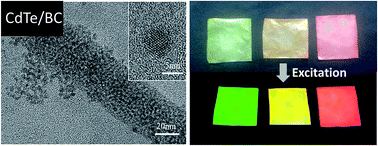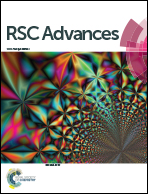Color-tunable luminescent CdTe quantum dot membranes based on bacterial cellulose (BC) and application in ion detection†
Abstract
Color-tunable luminescent membranes of CdTe QDs on bacterial cellulose (BC) nanofibers were successfully fabricated by in situ synthesis in aqueous solution. No nitrogen protection and expensive reagents are needed during the preparation process. The luminescent color of the CdTe/BC nanocomposite membranes with green, orange and red luminescence can be tuned easily by controlling the reaction time. The prepared CdTe/BC nanocomposites were characterized by X-ray diffraction (XRD), field effect scanning electron microscopy with energy dispersive X-ray analysis (FESEM-EDX) and transmission electron microscopy (TEM). Ultraviolet-visible (UV-vis), photoluminescence (PL) spectra and PL quantum efficiency (PL QE) were used to investigate the optical properties. Moreover, we attempted to make the luminescent membranes into an ion test paper. The green luminescent membranes had a good selectivity for Cu2+ with a detection limit of 0.016 mM and the mechanism of quenching Cu2+ were also explored. This work provides a simple, effective and eco-friendly method for the construction of luminescent CdTe QDs on BC membranes with high detectability for detection of Cu2+.


 Please wait while we load your content...
Please wait while we load your content...